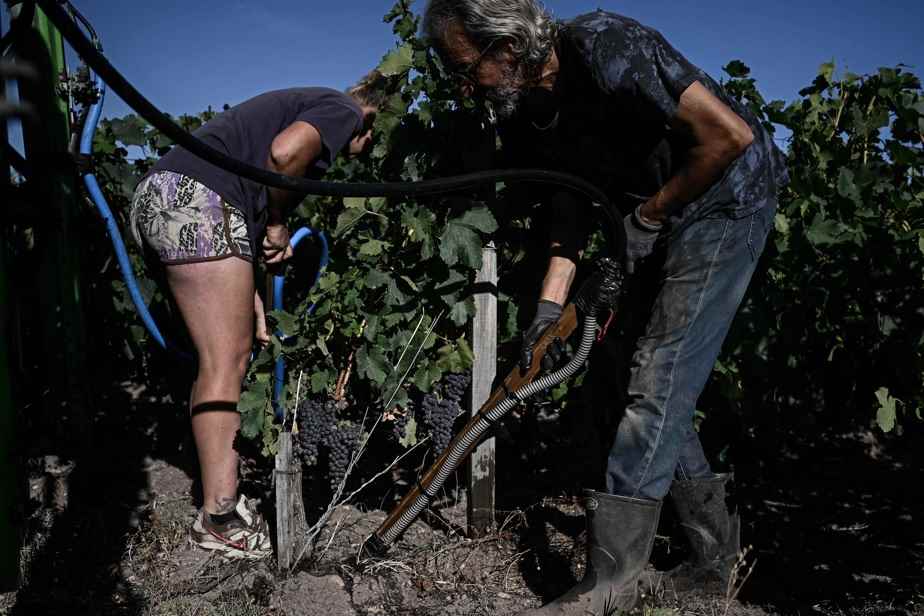(Mérignac) “As soon as you see yellowing: clac! », the water pipes are sinking at the foot of the vines. Near Bordeaux, at Château Picque Caillou, the young vines in bad shape have been watered since July, a practice prohibited except, by derogation, in the event of intense drought.
Posted at 7:01 a.m.
While France, like Western Europe, is experiencing its third episode of heat wave since June, saving the harvest is crucial for professionals in the wine world, already affected by poor production in 2021 after severe frosts and hailstorms, in particular.
And for good reason: France is the leading exporter of wine in the world and Bordeaux, the leading controlled designation of origin (AOC) vineyard in France with more than 100,000 hectares cultivated and 600 million bottles produced per year.
A little less than half is exported, mainly to Asia (China and Japan) and Europe (Belgium, Germany, United Kingdom, Switzerland).
At Château Picque Caillou, in the aisles of the Mérignac vineyard (Gironde, West), cultivated under the AOC Pessac-Léognan, two wine workers with skin scorched by the sun are busy, a garden hose in hand.
They bring up the rear of a green tractor, which, since mid-July, has been transporting water.
In the early morning, in clouds of smoke released by a dry and sandy ground, the thermometer is already approaching 30°C.
“We irrigate every morning, from 6:30 a.m. to noon,” says Paulin Calvet, owner of the estate. Each vine receives a volume of five liters of water, via a pipe connected to the cistern and inserted as close as possible to the roots.
The derogation requires that the water does not come from the network, but luckily, an active well is located a few hundred meters from the plots.
Of the 25 hectares of vineyard, nearly 10% will be irrigated this summer to limit the effects of the current drought: the young vines “three to eight years old”, specifies Paulin Calvet, fragile due to their roots that are too short to absorb the moisture in depth.
According to the forecaster Météo France, France had not experienced such a dry month of July since the beginning of the surveys in 1959.
“Zero millimeters of precipitation, it’s scary,” laments the winegrower. Especially since the Gironde has been sorely lacking in water in past seasons, leaving the soils dried out in depth in the summer.
Withered, yellowed, browned or even burnt leaves… although the vine thrives in an arid climate, on gravelly soil poor in water, it cannot withstand excessive dehydration.
“Everyone manages”
“Around July 10, we saw the first signs of drought appear,” explains Mr. Calvet. “We were really starting to worry. »
In viticulture, irrigation is prohibited each year, from 1er May until the harvest.
A dozen Gironde appellations can however request a derogation when water stress is “likely to call into question the quality of wine production”, according to the rural code.
This summer, while the periods of heat wave are linked in Gironde, three obtained the authorization to irrigate: those of Pessac-Léognan, Pomerol and Saint-Émilion.
But irrigation must be done sparingly, only on the vines whose survival depends on it.
“Stop the water! says Mr. Calvet to his workers. “Here, the feet are vigorous, that has no interest. »
On the Saint-Émilion side, “everyone manages”, confides the president of the AOC Wine Council Jean-François Galhaud, because “no one is really equipped for irrigation yet”.
Few derogations have so far been requested but in the long term, if the drought continues, “it is certain that it will be necessary to compensate”, “still it will be necessary that the water reserves are sufficient”, adds M Galhaud.
The profession, which has suffered in recent months from frost and hail, and now drought, is now hoping for “two or three storms in the coming weeks” which will promise, assures the interprofession of Bordeaux wines (CIVB), “a nice vintage “.
